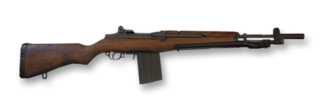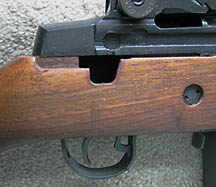The M14 rifle, officially the United States Rifle, Caliber 7.62 mm, M14, is an American select fire battle rifle chambered for the 7.62×51mm NATO cartridge. It became the standard-issue rifle for the U.S. military in 1957, replacing the M1 Garand rifle in service with the U.S. Army by 1958 and the U.S. Marine Corps by 1965. The M14 was used by the U.S. Army, Navy, and Marine Corps for Basic and Advanced Individual Training from the mid-1960s to the early 1970s.

The RK 62, officially 7.62 RK 62 and commercially M62, is an assault rifle manufactured by Valmet and Sako. It is the standard issue infantry weapon of the Finnish Defence Forces.

The Mini-14 is a lightweight semi-automatic rifle manufactured by Sturm, Ruger & Co. Introduced in 1973, the design was outwardly based on the M14 rifle and is, in appearance, a scaled-down version chambered in 5.56×45mm NATO, though with its own gas system design.
The karabinek szturmowy wzór 1996 "Beryl" is a Polish 5.56mm assault rifle, designed and produced by the Łucznik Arms Factory in the city of Radom. The rifle replaced the 5.45×39mm FB Tantal used in the Polish Armed Forces; it also replaced the Armed Forces' stock of 7.62×39mm AKM rifles for operational purposes, though reserve and training use of the AKM still continues to a limited degree.

The Colt Automatic Rifle-15 or CAR-15 is a family of M16 rifle–based firearms marketed by Colt in the 1960s and early 1970s. However, the term "CAR-15" is most commonly associated with the Colt Commando ; these select-fire carbines have ultrashort 10.5-inch (270 mm) and 11.5-inch (290 mm) barrels with over-sized flash suppressors.

The Squad Advanced Marksman Rifle (SAM-R) is a semi-automatic designated marksman rifle developed and used by the United States Marine Corps. It gave users the capability to provide fire in support of a rifle squad, providing precision fire in support of an assault, and aid in observation and adjusting of supporting arms.

The FN F2000 is a 5.56×45mm NATO bullpup rifle, designed by FN Herstal in Belgium. Its compact bullpup design includes a telescopic sight, a non-adjustable fixed notch and front blade secondary sight. The weapon has fully ambidextrous controls, allowed by a unique ejection system, ejecting spent cartridge casings forward and to the right side of the weapon, through a tube running above the barrel. The F2000 made its debut in March 2001 at the IDEX defence exhibition held in Abu Dhabi, in the United Arab Emirates.
The Ruger 10/22 is a series of semi-automatic rifles produced by American firearm manufacturer Sturm, Ruger & Co., chambered for the .22 Long Rifle rimfire cartridge. It uses a patented 10-round rotary magazine, though higher capacity box magazines are also available. The standard carbine version of the Ruger 10/22 has been in production continuously since 1964, making it one of the most successful rimfire rifle designs in history, with numerous third party manufacturers making parts and accessories for upgrading and customization. The 10/22's aftermarket is so prolific that a complete 10/22 can be built without using any Ruger-made components.
The Z-M LR-300 is an American rifle designed by gunsmith Allan Zitta and manufactured by Z-M Weapons. The model name LR-300 stands for Light Rifle and 300 is for 300 meters, which is regarded by the manufacturer as the effective range of the rifle with a standard 55 gr (3.6 g) FMJ bullet. The design is based on the AR-15, M16 and C7 rifles, but has a unique semi-direct gas impingement system and a folding stock option.

The Mk 14 Enhanced Battle Rifle (EBR) is an American military selective fire battle rifle, and a designated marksman rifle chambered for the 7.62×51mm NATO cartridge. It is a variant of the M14 battle rifle and was originally built for use with units of United States Special Operations Command, such as the United States Navy SEALs, Delta Force, and task specific Green Berets ODA teams/units.

The AS Val "Shaft" and VSS Vintorez "Thread Cutter", 6P30 and 6P29 respectively, were a Soviet-designed assault rifle featuring an integral suppressor based on the prototype RG-036 completed in 1981 by TsNIITochMash. The two rifles hereafter are referred to as the Vintorez and Val. The Vintorez and Val were developed by TsNIITochMash to replace modified general-purpose firearms, such as the AKS-74UB, BS-1, APB, and PB, for clandestine operations, much like the PSS Vul. Manufacturing began at the Tula Arms Plant after its adoption by the Armed Forces of the Soviet Union in 1987.

The SR-25 is a designated marksman rifle and semi-automatic sniper rifle designed by Eugene Stoner and manufactured by Knight's Armament Company.
The SG 550 is an assault rifle manufactured by SIG Sauer AG in Switzerland. "SG" is an abbreviation for Sturmgewehr. The rifle is based on the earlier 5.56×45mm NATO SIG SG 540.

The Marine Scout Sniper Rifle (MSSR) is a Philippine semi-automatic designated marksman rifle developed by the Philippine Marine Corps for their Marine Scout Snipers. Designed in the mid-1990s to replace severely-outdated battle rifles then used as marksman rifles, the MSSR is essentially an M16A1 that has been heavily modified and accurized to serve as a marksman rifle.

The BM59 is an automatic battle rifle developed in Italy in 1959. It is based on the M1 Garand rifle, chambered in 7.62×51mm NATO, modified to use a detachable magazine, and capable of selective fire. Later revisions incorporated other features common to more modern rifles.

The karabinek wz. 1996 Mini-Beryl is a Polish compact assault rifle (carbine) derived from the FB Beryl service rifle and chambered for 5.56×45mm. It was developed in parallel with the wz. 1996 Beryl by the "Łucznik" Arms Factory in Radom and introduced into service with the Polish Armed Forces in 1997 as the 5,56 mm karabinek krotki wz. 1996.

The Beretta ARX160 is an Italian modular assault rifle manufactured by Beretta. Developed for the Italian Armed Forces as part of the Soldato Futuro program, the ARX160 was launched in 2008 as a commercial weapon system independent from the Soldato Futuro ensemble, complete with a companion single-shot 40×46mm NATO low-velocity grenade launcher, called the GLX160, which can be mounted underneath the rifle or used with an ad hoc stock system as a stand-alone weapon.
The M39 Enhanced Marksman Rifle is a semi-automatic, gas-operated designated marksman rifle chambered for the 7.62×51mm NATO cartridge. It is a modified and accurized version of the M14 rifle used by the United States military, in a similar vein to the Mk 14 Enhanced Battle Rifle. It is based on the United States Marine Corps Designated Marksman Rifle (DMR), which it replaced. It is manufactured by Sage International and maintained by the USMC's Precision Weapons Section.
The Modular Sniper Rifle, or MSR, is a bolt-action sniper rifle developed and produced by Remington Arms for the United States Army. It was introduced in 2009, and was designed to meet specific United States Army and USSOCOM Precision Sniper Rifle requirements. The MSR initially won the PSR competition, and was called the Remington Mk 21 Precision Sniper Rifle in U.S. military service. However, it was then decided that the Mk 21 did not conform to SOCOM requirements at the time in 2018, and the program was re-competed with the Barrett MRAD selected in 2019 as the Mk 22 Advanced Sniper Rifle solution.















